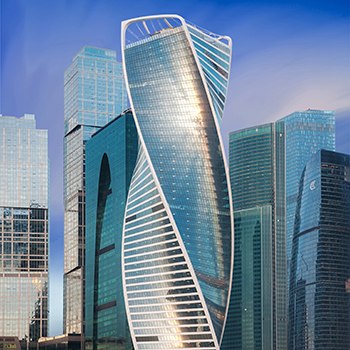Filter by
You must be a CTBUH Member to view this resource.

Evolution Tower
City Palace Tower, Wedding Palace
Building
Completed
2015
Office
All-Concrete
246 m / 807 ft
55
3
1292
17
7 m/s
82,000 m² / 882,641 ft²
You must be a CTBUH Member to view this resource.
You must be a CTBUH Member to view this resource.
Proposed
Construction Start
Completed
Usually involved in the front end design, with a "typical" condition being that of a leadership role through either Schematic Design or Design Development, and then a monitoring role through the CD and CA phases.
The Engineer of Record takes the balance of the engineering effort not executed by the “Design Engineer,” typically responsible for construction documents, conforming to local codes, etc.
Other Consultant refers to other organizations which provided significant consultation services for a building project (e.g. wind consultants, environmental consultants, fire and life safety consultants, etc).
These are firms that consult on the design of a building's façade. May often be referred to as "Cladding," "Envelope," "Exterior Wall," or "Curtain Wall" Consultant, however, for consistency CTBUH uses the term "Façade Consultant" exclusively.
Material Supplier refers to organizations which supplied significant systems/materials for a building project (e.g. elevator suppliers, facade suppliers, etc).
You must be a CTBUH Member to view this resource.
Usually involved in the front end design, with a "typical" condition being that of a leadership role through either Schematic Design or Design Development, and then a monitoring role through the CD and CA phases.
The Design Engineer is usually involved in the front end design, typically taking the leadership role in the Schematic Design and Design Development, and then a monitoring role through the CD and CA phases.
The Engineer of Record takes the balance of the engineering effort not executed by the “Design Engineer,” typically responsible for construction documents, conforming to local codes, etc.
The Design Engineer is usually involved in the front end design, typically taking the leadership role in the Schematic Design and Design Development, and then a monitoring role through the CD and CA phases.
The Engineer of Record takes the balance of the engineering effort not executed by the “Design Engineer,” typically responsible for construction documents, conforming to local codes, etc.
The main contractor is the supervisory contractor of all construction work on a project, management of sub-contractors and vendors, etc. May be referred to as "Construction Manager," however, for consistency CTBUH uses the term "Main Contractor" exclusively.
Other Consultant refers to other organizations which provided significant consultation services for a building project (e.g. wind consultants, environmental consultants, fire and life safety consultants, etc).
These are firms that consult on the design of a building's façade. May often be referred to as "Cladding," "Envelope," "Exterior Wall," or "Curtain Wall" Consultant, however, for consistency CTBUH uses the term "Façade Consultant" exclusively.
Material Supplier refers to organizations which supplied significant systems/materials for a building project (e.g. elevator suppliers, facade suppliers, etc).
2015 CTBUH Awards
4 September 2017 - Event
18 August 2016 - CTBUH Research

12 November 2015 | Moscow
Hiroo Mori, Director & Executive VP, Mori Building, Philip Nikandrov, Chief Architect, Gorproject, James Goettsch, CEO & Partner, Goettsch Partners, Jan Andersson, Senior Advisor, HSB...

01 August 2016
Philip Nikandrov, GORPROJECT
The Evolution Tower, Moscow, set off a wave of imitators when its design was first revealed in 2004, but it took another 12 years for...
2015 CTBUH Awards

12 November 2015 | Moscow
Hiroo Mori, Director & Executive VP, Mori Building, Philip Nikandrov, Chief Architect, Gorproject, James Goettsch, CEO & Partner, Goettsch Partners, Jan Andersson, Senior Advisor, HSB...

12 November 2015 | Moscow
Philip Nikandrov, Chief Architect, Gorproject, speaks at the 14th Annual Best Tall Building Symposium in a presentation entitled "Evolving Russian Tall Building Typologies: Evolution Tower,...

12 November 2015 | Moscow
Philip Nikandrov, Chief Architect, Gorproject, is interviewed by Chris Bentley regarding the Best Tall Building Featured Finalist, the Evolution Tower, Moscow, during the 2015 CTBUH...
7 September 2017
22 speakers discussed the state of high-rise design & construction at this conference, a partner event between the CTBUH and Samara State Technical University.
Subscribe below to receive periodic updates from CTBUH on the latest Tall Building and Urban news and CTBUH initiatives, including our monthly newsletter. Fields with a red asterisk (*) next to them are required.
View our privacy policy